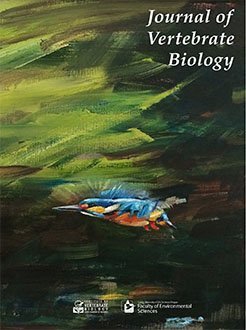Hiroshi Tsunoda, Stanislava Peeva, Evgeniy Raichev, Thomas Kronawetter, Krasimir B. Kirilov, Dian Georgiev, Yayoi Kaneko
Journal of Vertebrate Biology 71 (22018), 22018.1-11, (27 July 2022) https://doi.org/10.25225/jvb.22018

KEYWORDS: competition, daily activities, intraguild, landscape modifications, niche partitioning
In mammalian carnivore guilds (order Carnivora), spatiotemporal partitions play a major role in reducing competitive confrontations and facilitating successful sympatry. Using camera-trapping techniques, the present study aimed to elucidate patterns of spatial distribution and diel activities among medium- and large-sized carnivore species across central Bulgaria. We obtained 3,364 images of nine focal carnivores from 13,988 camera-trapping days between 2015 and 2020. Our findings indicated that the spatial distribution of the focal carnivore guilds varied with changes in altitudinal gradient, ruggedness, and forest-agricultural landscape changes. Specifically, the two largest species, the grey wolf (Canis lupus Linnaeus, 1758) and the brown bear (Ursus arctos Linnaeus, 1758), were found only in the Balkan Mountains, whereas the largest mesocarnivore, the golden jackal (Canis aureus Linnaeus, 1758), was mainly distributed agricultural lowlands. The European wildcat (Felis sylvestris Schreber, 1777) was found in forests inside protected areas, and other mesocarnivores were distributed at intermediate levels between wooded-mountains and agricultural lowlands. Brown bear, golden jackal, and domestic dog (Canis lupus familiaris Linnaeus, 1758) showed cathemeral, crepuscular, and diurnal activity, respectively, whereas the remaining six carnivores showed nocturnal activity in synchrony with their main prey. Our findings indicated that anthropogenic landscape modifications and potential interspecific competition resulted in patterns of spatial distribution and temporal activity in this carnivore guild.

